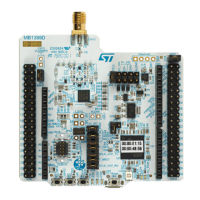RM0453 Rev 1 225/1461
RM0453 Power control (PWR)
276
Dynamic voltage scaling to increase V
CORE
is known as “overvolting”. It is used to improve
the device performance.
Dynamic voltage scaling to decrease V
CORE
is known as “undervolting”. It is used to save
power, particularly in laptop and other mobile devices where the energy comes from a
battery and is thus limited.
• range 1: high-performance range
The main regulator provides a typical output voltage at 1.2 V. The system clock
frequency can be up to 64 MHz. The Flash memory access time for read access is
minimum. Write and erase operations are possible.
• range 2: low-power range
The main regulator provides a typical output voltage at 1.0 V. The system clock
frequency can be up to 16 MHz.The Flash memory access time for a read access is
increased as compared to range 1. Write and erase operations are possible.
Voltage scaling is selected through the VOS bit in the PWR control register 1 (PWR_CR1).
The sequence to go from range 1 to range 2 is the following:
1. Reduce the system frequency to a value lower or equal to 16 MHz.
2. Adjust number of wait states according to new frequency target in range 2 (LATENCY
bits in the FLASH_ACR).
3. Select range 2 with the VOS bits in the PWR control register 1 (PWR_CR1).
The sequence to go from range 2 to range 1 is detailed below:
1. Select range 1 in the VOS bits in the PWR control register 1 (PWR_CR1).
2. Wait until the VOSF flag is cleared in the Power status register 2 (PWR_SR2).
3. Adjust number of wait states according new frequency target in range 1 (LATENCY bits
in the FLASH_ACR).
4. Increase the system frequency.
6.2 Power supply supervisor
6.2.1 Power-on reset (POR)/power-down reset (PDR)
/Brownout reset (BOR)
The device has an integrated power-on reset/power-down reset, coupled with a Brownout
reset circuitry.
Five BOR thresholds can be selected through option bytes.
BOR0 level cannot be disabled. Other BOR levels can be enabled by user option. When
enabled, BOR is active in all power modes except in Shutdown.
Reset mode
During power-on, BOR keeps the device under reset until the supply voltage V
DD
reaches
the specified V
BORx
threshold. When V
DD
drops below the selected threshold, a device
reset is generated. When V
DD
is above the V
BORx
upper limit, the device reset is released
and the system can start.
For more details on the Brownout reset thresholds, refer to the electrical characteristics
section in the datasheet.

